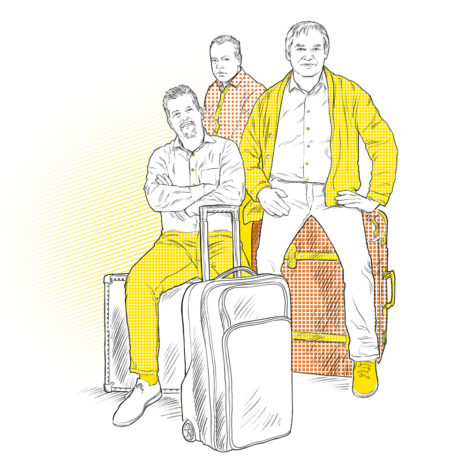The bags are packed. Rainer Ehrhardt and his colleagues are just waiting for the call to travel to Dubai to commission their air conditioners. But the call does not come. “The quality we delivered was just too high,” explains Ehrhardt, struggling to refrain from laughing. “Our systems worked from the word go.” Ehrhardt is a sales engineer at Walter Roller GmbH. From Bremen, he supports the maritime contracts of the company based in Gerlingen near Stuttgart.
A hive of activity on site
The story with Dubai was a very special task. At the Dry Dock World there, the BorWin gamma converter platform from network operator TenneT was towering up into the blue Arabian sky. Its destination: the Hohe See and Global Tech I wind farms, around 100 kilometers off the coast of the North Sea island of Borkum. In the fall of 2018, following completion, the 18,000 metric ton yellow colossus made the 12,000 kilometer journey on board a transport ship.

The Walter Roller team waiting: Rainer Ehrhardt, Wolfgang Krenn and Ingo Raisch. (Illustration | Bernd Schifferdecker; Gernot Walter)
164 Roller air conditioners operate in the offshore platform. They are mounted in communal areas, such as the canteen or control room, as well as in technical functional areas, such as the converter rooms. The order kept the manufacturing company, with its 110 employees and head-quarters in Gerlingen, Germany, quite busy. “All of the units for the project were one-off products,” says Managing Director Wolfgang Krenn. “Producing this number in a relatively short space of time — it was a hive of activity here.” But it was not just the short time period between the order and delivery to the Port of Hamburg that was challenging — the technical, spatial, and administrative requirements were also special.
Copper, not aluminum
As the salt content of the sea air is extremely high, the standard aluminum ribs in air conditioners corrode faster. For BorWin gamma, Roller therefore used ribs made from copper for the heat exchangers. This made the units about a third heavier, however. “This makes no difference for smaller units,” explains Head of Development Ingo Raisch. “But for large air coolers, we had to attach reinforced mountings.”
„If something isn’t working in the chiller room of your local baker, you just drop by. That is, of course, difficult with this project.“
Rainer Ehrhardt, sales engineer at Walter Roller
And from a weight of 25 kilograms, special mountings were necessary, so-called lifting lugs. “We attached each individual unit to a crane in order to test whether they work — since then everyone here in production knows what lifting lugs are.” But the inside of the unit also has to cope with salt so that both cold water and salt water can be used for cooling.

Ribs made of aluminum are standard in air conditioners. However, the material corrodes faster in air containing salt. For BorWin gamma, ribs made from copper were used in the heat exchangers. (Illustration | Bernd Schifferdecker; Gernot Walter)
The air coolers must also be able to heat the air. This is because there is a risk of condensation forming in the rooms on board the platform on days when the turbines of the wind power plants are stationary. As there is plenty of electricity, the choice was made for electric heating. “For us, this was a real exception which was also quite difficult to realize,” says Raisch, looking back. Furthermore, it had to be ensured that the surface of the units did not exceed a certain temperature. “During our tests, it sometimes took hours before the heating element had brought the unit up to the critical temperature — and we had identified the hottest point on the unit.”
The units were also finally signed off in Gerlingen. For one week, a large international team assessed the performance and sound measurements on the individual unit types. “This only worked out because a small area in production was in the process of being converted at the time and so was empty,” explains Managing Director Krenn. The focus of the tests was on durability, as Rainer Ehrhardt highlights: “If something isn’t working in the chiller room of your local baker, you just drop by. That is, of course, difficult with this project.”
This also demanded the highest level of reliability from the fans in the units. This is provided by the ebm-papst centrifugal fans in the ten large air conditioners, and the axial fans in the high-performance air coolers. In their motors, particularly robust bearings are used, for example.

Travelling colossus: the converter platform Borwin gamma at the start of its journey at Dubai. (Illustration | Bernd Schifferdecker; Gernot Walter)
Thanks to the EC technology of the fans, there was one requirement that the team did not have to worry about: “Thermal contacts were required for connecting the fans — but here the electronics are already integrated.”
Alongside the high quality when it came to technology and production, a third factor played a crucial role in the project going so well: the detailed documentation. “We had already solved lots of eventualities in advance,” explains Krenn. “This is why we have not had any queries so far.” But also no trip away.

Leave a comment